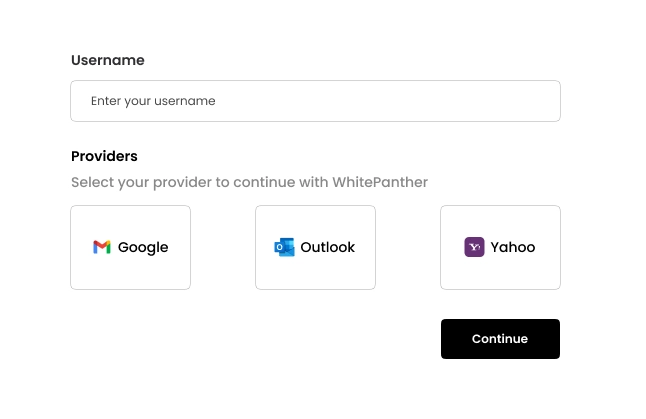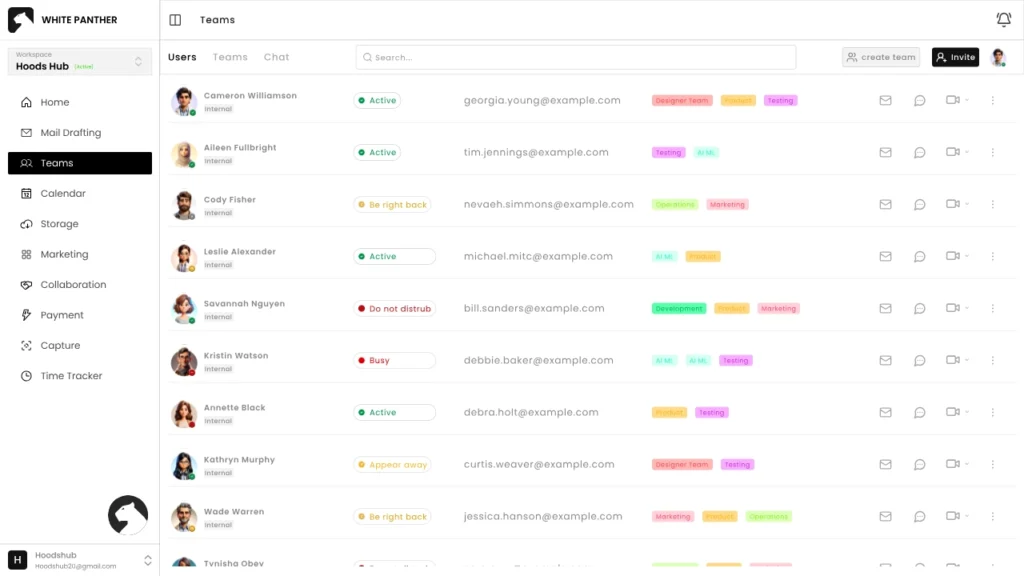When we had the idea to launch WhitePanther, the vision was exciting: one dashboard for everything: emails, files, payments, chats, projects, and even AI assistance.
But one of the first challenges hit us right away: how do you bring all this together securely?
We knew people wouldn’t just be trusting us with to-do lists.
They’d be trusting us with client conversations, confidential reports, payment details, and their team’s daily operations.
If anything went wrong, it wouldn’t just be a bug. It would be a breach of trust.
So security and privacy became the foundation.
Every feature we designed, we asked ourselves: “Would we feel safe using this for our own work?” If the answer was no, we reworked it until it was.
Here’s how we built WhitePanther to keep your data safe while still making work seamless.
How did we build Whitepanther to be Secure and Private?
1. Login Without Fear: OAuth and SSO
When we thought about connecting emails, the first thing we asked ourselves was: would we personally feel comfortable giving away our Gmail or Outlook credentials? The answer was obvious, NO.
That’s why we built WhitePanther with OAuth2 authentication, the same method Google and Microsoft recommend.
- You connect Gmail, Outlook, Drive, or Dropbox directly.
- We never see or store your password.
- Your emails and files stay encrypted with the original service.
And to make sure even a leaked password doesn’t mean a leaked account, we enforce Multi-Factor Authentication (MFA) for organizational workspaces

2. Encryption Everywhere
When we looked at how attachments and files are usually handled in workplace tools, we saw a problem: too many services keep unencrypted backups or don’t expire links. That’s a weak spot waiting to be exploited.
So, we made encryption a rule, not an option.
- AES-256 secures everything at rest. your emails, attachments, and files.
- TLS 1.3 protects data in transit, whether you’re on office WiFi or an airport hotspot.
Shared files can be sent as time-limited encrypted links, hashed and permission-controlled.
That way, even if someone manages to get hold of a link, it won’t work past its expiry.
3. Built-In Team Chats and Meetings
We didn’t want to build yet another chat app, we wanted team communication baked right into Whitepanther. That way, you can switch from email to chat or start a meeting without juggling tabs.
But integrating chat and video means handling live messages, calls, and files. We designed them with these protections:
- Chats are encrypted end to end, with role-based permissions for group access.
- Video calls run inside the workspace, so you don’t have to share links across insecure apps.
- Audit logs are kept for admins only, no one else can snoop.

4. In-Built Project Management & Time Tracker
We wanted teams to assign tasks, track progress, and log hours without plugging in five third-party tools. So we added lightweight project management and time tracking directly into WhitePanther.
But more features means more sensitive data, who’s working on what, for how long, with which clients. To keep that safe, we added:
- Role-based access so only project leads can see certain reports.
- Secure exports of timesheets as encrypted CSVs or PDFs.
- Trails for task changes, so managers know who edited what and when.
5. Screen Recording Without Risk
A screen recorder inside a productivity platform sounds convenient, but it also raised security questions for us. Recordings often contain confidential data, client dashboards, payment portals, even private team conversations.
So we built recording with privacy-first defaults:
- Recordings are saved directly to your linked cloud storage (Google Drive/Dropbox) or to secure in-app storage.
- Files are encrypted immediately upon upload.
- Links are shareable only with explicit permissions, and can expire automatically.
This way, you can share a demo or tutorial without worrying about leaks.
6. Payments That Don’t Expose You
Adding in-built payments was a big decision. With Razorpay integrated (and Stripe/PayPal on our roadmap), teams can handle client payouts and bulk transactions right inside WhitePanther.
But handling payments means handling sensitive financial data. Here’s how we locked it down:
- All bank details, UPI IDs, and cards are encrypted before storage.
- Only specific roles can initiate or approve payouts, no accidental clicks from team members.
- Every transaction is logged, with filters and history so you can review them anytime.
And since we only work with PCI-DSS-compliant gateways, your money never touches insecure rails.
7. Cloud Storage Without Compromise
For files, we gave users option to connect existing services like Drive/Dropbox,
Either way, security was non-negotiable:
- OAuth2 keeps logins secure for third-party storage.
- Sharing always requires explicit permissions.
- Quota usage and space tracking are transparent so you know exactly where data sits.
8. Compliance That’s Verified
Anyone can say they’re compliant. But we wanted proof. That’s why we built compliance into the platform and got it independently checked.
- ISO 27001 practices: followed across engineering and operations.
- Audited by professional ISO-certified auditors: we don’t just self-assess, we undergo external audits.
- GDPR and CCPA ready: data rights like export, deletion, and opt-out are built in.
- CAN-SPAM compliance: we have planned consent management so all marketing campaigns come with opt-in/out options.
It’s not just paperwork, it’s how we keep your business safe across regions.
9. Data Residency by Design
Different regions demand different data laws. We didn’t want data bouncing across continents when it shouldn’t.
So WhitePanther supports region-specific hosting:
- AWS Mumbai for Indian teams.
- AWS Frankfurt for European customers.
- US servers for North America.
That means your data stays where it should, helping you meet local sovereignty requirements automatically.
10. Monitoring and Threat Response
When we tested early versions, we realized building security once wasn’t enough. Threats evolve daily.
So we set up continuous monitoring and strict response protocols:
- Automated vulnerability scans to catch weak spots.
- Penetration testing by external experts.
- Quarterly security audits across the whole stack.
- High-severity issues patched within 72 hours.
- MTTD (Mean Time to Detect) incidents under 5 minutes.
- MTTR (Mean Time to Resolve) under 30 minutes for critical problems.
It’s not about if something happens, but how fast we can detect and fix it.
11. Backup and Recovery
We also asked ourselves: what happens if servers fail? What if there’s a major outage?
The answer was to build recovery in from the start:
- Daily automated backups of user data.
- Recovery Point Objective (RPO): less than 24 hours (you won’t lose more than a day’s work).
- Recovery Time Objective (RTO): under 1 hour (systems back online quickly).
This way, you don’t just trust us with your work today, you trust us to safeguard it tomorrow.
12. Zero Trust, Always
Finally, we didn’t want to assume any system, device, or request was “safe by default.” That assumption is how breaches spread.
Instead, we follow a Zero Trust model:
- Every login is verified.
- Every session is authenticated.
- Every device is checked before accessing data.
This reduces the blast radius even if an attacker gets through one layer.
Why We Care About Privacy
WhitePanther isn’t just about productivity, it’s about trust.
- Trust that your inbox stays private.
- Trust that your files aren’t shared behind your back.
- Trust that your payments are only seen by the right people.
That’s why we never sell user data. We don’t build features that compromise confidentiality.
Privacy isn’t just a compliance checkbox for us, it’s the reason people choose us over juggling ten other tools.
Final Words
When we started Whitepanther, we thought the hard part would be packing email, payments, chats, and projects into one dashboard.
But the truth is, the hardest part was earning trust.
That’s why we built security and privacy into the DNA of WhitePanther.
From OAuth logins to encrypted files, from in-built project tools to audited compliance, everything is designed to make your work safe.
Because productivity only matters when it’s built on trust. And for us, trust isn’t optional, it’s the whole product.


